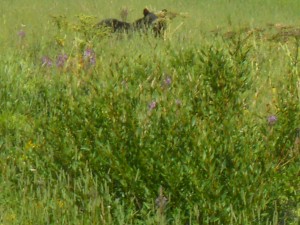
A grizzly bear gazes through vegetation in Yellowstone National Park. Photo courtesy of Madeline Hirshan.
Climate change is a phenomenon that has been a long time in the making. The last ice age ended about 7,000 years ago. This spawned the beginning of the era of human civilization. In the past, changes in climate mostly occurred from variations in Earth’s orbit affecting how much solar energy reached Earth’s surface. More recent trends lean towards rapid changes in climate due to human induced warming. According to BBC News, the likely source of climate change occurred during the 18th century with the onset of the Industrial Revolution. Centuries of human population growth and discovery have led us to this troubling point. Investigations of “greenhouse gases” had begun as early as 1824 and research regarding their properties took place around 1861. The current state of the Earth’s climate can be attributed to numerous causes including the burning of fossil fuels which trap heat in the atmosphere and re-emit it back to the surface.
Although there are many ways in which humans have left a negative carbon footprint on this planet, many important decisions had been made in the past that have preserved the environment in some fashion. National parks were created to protect key areas from extreme human intervention. Yellowstone National Park was formed in 1872 and was placed under the control of the Secretary of the Interior. The Yellowstone Act states: “He [Secretary of the Interior] shall provide against the wanton destruction of the fish and game found within said park, and against the capture or destruction for the purposes of merchandise or profit.” The numbers of national parks have increased and continue to preserve diverse and immaculate landscapes and wildlife in addition to unique cultural and historical sites. The National Parks System of the United States currently has more than 400 locations represented in forty-nine states.
Science regarding climate change has been conducted for many years. As early as 1997, research had been conducted in Yellowstone National Park. The 1997 study examined vegetation in Yellowstone and modeled changes due to increased carbon dioxide concentrations in the atmosphere. It also pointed out the uncertainty associated with climate change predictions which is a very important factor. Many monitoring studies that are currently being undertaken began many years ago. A study performed by the Greater Yellowstone Inventory and Monitoring Network (GRYN) used satellite imaging to look at changing seasonal patterns of vegetation growth and snowpack melt for eleven years. Researchers seek to understand the relationship between the snow melt and the timing of certain vegetative events as possible indicators for climate change. Although much research on climate change in national parks is vegetation based, changes in vegetation and snowpack melt ultimately impact wildlife food supply and habitats. Wildlife within the national parks have also been continuously monitored over the years. The early beginnings of research monitoring wildlife are essential for observing changes in population dynamics over time. A very important example of one species that has been especially important is the grey wolf in Yellowstone National Park. Researchers routinely collect data from radio-collars on wolves within the park to observe changes in population size and body size that can likely be attributed to environmental factors. Wolves were re-introduced into Yellowstone in the 1990s. The fact that wolf populations are currently about 1,700 in surrounding states can likely indicate that wolves may be able to cope with global warming. However, more research is necessary to understand predator-prey dynamics as well as fertility and changes in life span. Currently the livelihood of numerous wildlife species in national parks rely on scientific findings that will indicate the likely risks associated with increased global warming. Although more research is needed, many scientists do understand that some species may be at risk as a result of climate change. These species include the pika, polar bear, and grizzly bear. Understanding the key underlying causes of these changes in national parks can be significant for posing possible solutions.
It may be surprising that the idea of global warming has been around for over 100 years. There has been a long evolutionary history of global warming and this issue is extremely significant today. The destructive forces resulting from human dominance over nature appear to be winning. Humans have tried to set nature aside as a way to preserve its natural beauty and ecological qualities in national parks. Although protected, national parks and the wildlife and vegetation within them are at risk of large changes over time. The history and impact of climate change on national parks has led to this situation. There is a need to evolve science to facilitate the understanding of a very complex process and species at risk.